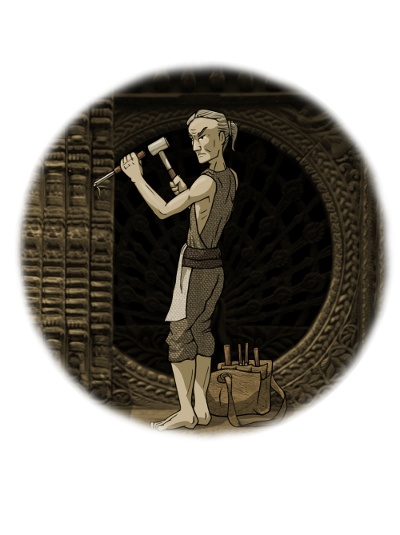Many thanks to Tristan Morris for creating a beautiful illustrated hardcover print edition of the site

 |
|
 |
 |
 |
|
 | |
 | |
 | |

Master Bawan was conducting an initiate monk through the temple grounds. Eventually they came to the Hall of Wasted Hours, where the abbots held their morning meetings. Bawan pointed to the four massive oak pillars that held up the oldest part of the hall. Scenes of temple life had been carved into each, on all four sides and stretching from floor to distant ceiling. The intricate figures possessed such astounding verisimilitude that the monk could almost hear the clacking of abaci.
“These were fashioned two hundred years ago by a monk of our order,” said Bawan. “It took him six years, laboring every night with a hammer and chisel, his work lit only by the glow of a single flickering cathode tube.”
Further down they came to another square of four pillars, identical to the first square in every way.
“These were made a hundred years ago by monks of the Harmful Go-To Clan, which has since been banished,” said Bawan. “They replicated the originals with a bamboo pantograph secured to an electric router. It took them six months, working by the light of a discarded CRT running Anantha's Fountain.”
Further down they came to yet another square of four pillars, even more like the originals.
“These were created fifty years ago by three nuns of the Elephant's Footprint Clan, which tends our databases and secures our history,” said Bawan. “The nuns traced the contours of the originals and fed the coordinates into a programmable milling machine. The measuring took six weeks; the carving a few days.”
Finally they came to the new south portico, supported by a final square of pillars so like the first that the slightest stray chisel mark had been reproduced faithfully.
“These were installed ten years ago by one of our summer interns,” said Bawan. “He photographed the originals with high resolution digital cameras, combined the data into a three-dimensional topographic mesh with sub-millimeter resolution, and outsourced the manufacture to a mill in the next province. Six days, end to end.”
Bawan faced the initiate monk. “Which set of pillars is of greatest value to the Temple?”
The monk considered and said, “The ones that exist purely as data gathered by the intern. For though they have neither height nor breadth nor weight, still from them all other pillars could be remade.”
Bawan bowed and led the monk out.

That night Bawan walked alone by lantern light through the hardware archives of the Clan of Iron Bones, in the deepest cellars under their abbey. Finding at last the particular VAX mainframe he sought, Bawan hooked up a dusty VT100 terminal, flipped on the power toggle, and opened a C source file that had not been compiled for a quarter of a century.
Bawan noted with satisfaction how perfectly the statements had been indented, how descriptive the function and variable names were, how thoroughly each parameter had been commented. He smiled at a few TODO and FIXME comments: an appeal to a future that would never answer back. Then he scrolled to the top where his own name and email address appeared proudly.
“The initiate was only half-right,” said Bawan to the emptiness. “True, the value lies not in carven oak, but neither does it lie in the shape of the carving; for both the real pillar and the virtual one may be lost, and the temple will be no poorer. But when wood first yields to metal, one more thing is made: and that is the sculptor.”
An excerpt from The Codeless Code, by Qi (qi@thecodelesscode.com).
Provided under the Creative Commons Attribution-NonCommercial 3.0 Unported License.














